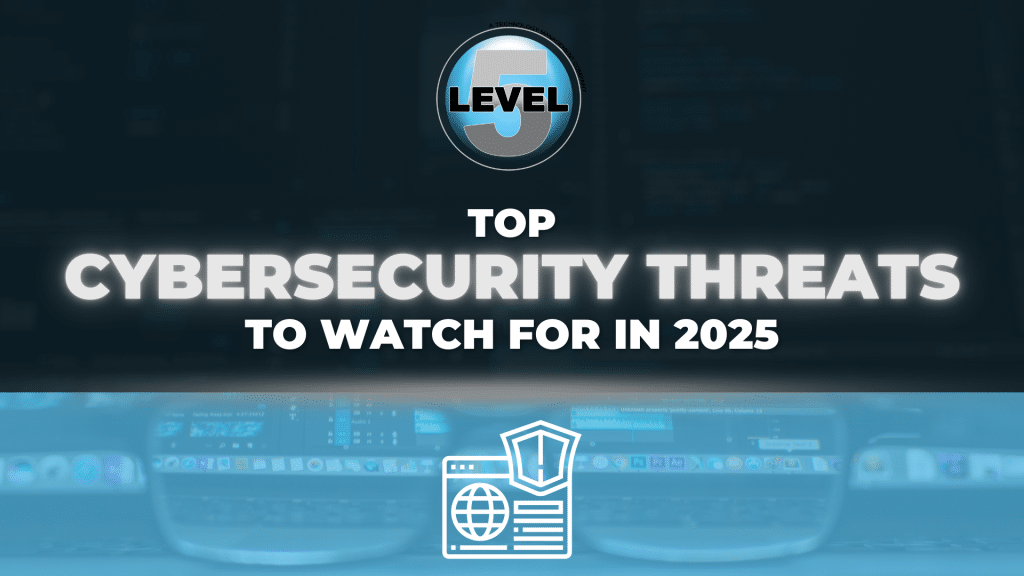Cybercriminals constantly change their strategies and utilize cutting-edge technologies to take advantage of weaknesses in even the most secure systems. As 2025 approaches, it is anticipated that these cybersecurity threats will become more complex, underscoring the need for robust and proactive cybersecurity solutions.
Level 5 Management is a managed IT and cybersecurity solutions company in Boca Raton, Florida. This blog will look at the most crucial new cybersecurity threats businesses face, offer helpful tips, and help you prepare for what lies ahead.
The Changing Cybersecurity Environment in 2025
The cybersecurity landscape is rapidly changing due to technological advancements and the increasing integration of digital technology into business processes. According to a 2003 estimate, the yearly cost of cybercrime will increase from $3 trillion in 2015 to $10.5 trillion by 2025.
Businesses lost an average of $1.85 million per incident, including recovery costs, as ransomware assaults increased by 13%. These numbers highlight the necessity of increased awareness and cutting-edge defenses as businesses prepare for changing threats.
Emerging Threats to Watch For
Several new cybersecurity threats for businesses are expected to dominate headlines in 2025. Here’s a closer look:
1. Cyberattacks Driven by AI
Artificial intelligence (AI) is revolutionizing both attackers and defenders. Cybercriminals are using AI more and more to automate tasks like developing malware and scanning for weaknesses. AI-powered attacks can adapt in real-time and circumvent traditional defenses.
These attacks can disrupt operations, steal private data, and harm reputations. For instance, phishing attempts powered by pAI can generate plausible fake messages that trick employees into divulging login information.
Strategies for Mitigation:
- AI-Based Defense Systems: Use AI technologies to instantly identify irregularities and react to dangers.
- Frequent Training: Teach staff members how to spot phishing scams and other AI-powered dangers.
2. Deepfake Scams Aimed at Companies
Deepfake technology, which creates remarkably realistic fake audio and video for fraudulent purposes, is becoming increasingly popular. By impersonating executives, cybercriminals might spread misleading information or permit fraudulent transactions.
Businesses risk financial losses, reputational damage, and legal repercussions if deepfake frauds are not detected.
Strategies for Mitigation:
- Verification Protocols: Use multi-factor authentication (MFA) for any critical communications.
- Awareness Campaigns: Teach employees to recognize warning signs in audio or video communications.
3. Deepfake Scams Targeting Businesses
The usage of deepfake technology, which produces incredibly lifelike phony audio and video for fraudulent purposes, is growing. Cybercriminals can circulate false information or allow fraudulent transactions by posing as executives.
If deepfake frauds are not identified, businesses may suffer monetary losses, harm to their reputation, and legal consequences.
Strategies for Mitigation:
- Verification Protocols: Implement multi-factor authentication (MFA) for all critical communications.
- Awareness Campaigns: Train staff to spot red flags in video or audio communications.
4. Advanced Ransomware Incidents
Ransomware attacks are becoming more targeted and sophisticated, even bringing down entire businesses. These days, a popular approach is a double extortion, where the attacker encrypts the stolen material and threatens to reveal it.
Significant operational and financial disruptions might result from a single ransomware event. For example, ransomware attacks will cost businesses over $265 billion by 2031.
Strategies for Mitigation:
- Regular Data Backups: Maintain secure, offline backups to restore data without paying ransoms.
- Threat Detection Systems: Deploy advanced tools to identify and neutralize ransomware early.
5. IoT Vulnerabilities and Zero-Day Exploits
Millions of people worldwide are connected by the Internet of Things (IoT), yet many require strong security features. Because of this, zero-day exploits—vulnerabilities that are unknown to the manufacturer or the general public—find IoT networks appealing targets.
Compromised IoT devices can serve as entry points for more significant network breaches. In 2022, over 4.1 million websites were infected with malware, with many attacks exploiting IoT vulnerabilities.
Strategies for Mitigation:
- Secure Configurations: Regularly update firmware and turn off unnecessary features.
- Network Segmentation: Isolate IoT devices on separate networks to limit exposure.
How Businesses Can Stay Protected
Preparing for cybersecurity threats in 2025 requires a multi-layered approach. Businesses should consider the following strategies:
- Perform thorough risk assessments: Assess your IT infrastructure regularly to find and fix any vulnerabilities.
- Invest in Staff Education: Teach staff to spot dangers like deepfake scams and phishing.
- Adopt Multi-Layered Security Solutions: To build a strong defense, combine intrusion detection systems, firewalls, and encryption.
- Create an incident response plan: This should outline precise procedures for addressing cyberattacks to reduce harm.
Partner with Cybersecurity Experts: Work with experts like Level 5 Management to keep ahead of new threats.
Final Thoughts
The growth of new cybersecurity threats highlights the need for proactive defensive tactics for businesses. From AI-driven attacks to IoT vulnerabilities, the risks are numerous and severe. However, companies can avoid these difficulties with the correct relationships and strategies.
Level 5 Management is dedicated to assisting companies in navigating the intricacies of contemporary cybersecurity. Our cybersecurity solutions are designed to help businesses protect their digital assets in Boca Raton, Florida, and around the globe. We offer the resources and know-how to safeguard your company in 2025 and beyond, from sophisticated threat detection to staff training initiatives. Contact us to learn more.


